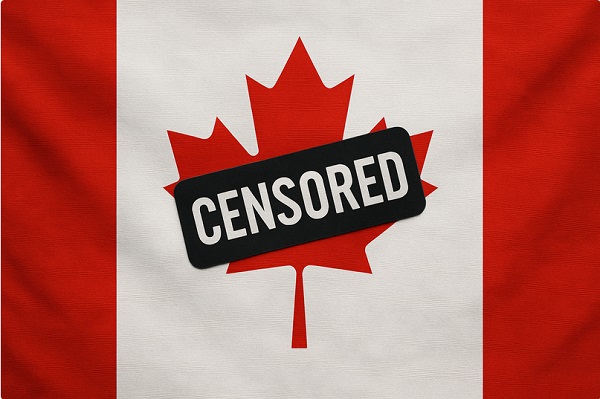MacDonald Laurier Institute
Anti-Jewish campus protests reveal ugly double standard when it comes to policing “free speech”

From the Macdonald Laurier Institute
By Kelsie Walker for Inside Policy
Despite encampments trespassing on private property, and thus being, by all definitions, illegal, they’ve seen practically no disciplinary action.
Following widespread pro-Palestinian protest encampments popping up on American campuses, there was an influx of copycat encampments across major Canadian university campuses, including at the University of Toronto, McGill University, the University of British Columbia, the University of Calgary, the University of Ottawa, and Western University, among others. These encampments are demanding that universities divest from entities associated with Israel, accusing them of supporting apartheid and being complicit in genocide. The protests, intended to express solidarity with Palestinians but also rife with antisemitism and calls for violence against Jews, have sparked intense debates about the limits of free speech and the legal boundaries of protests on campuses.
What began as a story of peaceful activism has quickly turned into lawmakers, universities, and the police selectively enforcing the law on partisan lines, displaying both hypocrisy and inaction when it comes to handling protests associated with the left.
A new poll from the Angus Reid Institute found that two-thirds of Canadians (64 per cent) say the police give preferential treatment to certain groups when dealing with protests. Canadians of all political affiliations largely feel that police response and engagement at protests is not applied consistently, with three-in-five past Conservative (68 percent), Liberal (60 percent), and NDP (73 percent) voters saying so. While they differ on the question of who receives preference, given the recent events at Canadian universities, it is undeniable that left-leaning causes, and more specifically, pro-Palestinian protests, are given unfair leeway in comparison to causes deemed to be right-leaning.
While some have tried to frame the campus encampments as an issue of free speech, in many cases, the protesters are breaking clearly defined and communicated laws. Students are certainly free to protest. However, they must also comply with university policies and Canadian laws. Free speech allows individuals to express their opinions, even controversial or unpopular ones. However, when the expression of an opinion crosses into illegal activity, such as vandalism, trespassing, or the incitement of violence, it is no longer protected under the banner of free speech. Yet, pro-Palestinian protestors are demanding that their protests be held above the law, and such demands are being met.
Despite encampments trespassing on private property, and thus being, by all definitions, illegal, they’ve seen practically no disciplinary action. The majority of Canadian universities are either placating protestors’ demands by offering a list of concessions, or, they are simply letting protests proceed practically unchecked. Police did recently disperse the encampment at McGill University on June 6 – but only after protesters there escalated the situation by illegally occupying an administration building. While most protestors have good intentions, illegal and alarming activity is frequently occurring in protest sites. Encampments have, at times, seen physical conflicts with counter-protesters, the presence of anti-Canadian and anti-police slogans, the refusal of numerous orders to leave, have issued calls to incite violence, and in one instance, have even displayed shocking imagery depicting the lynching of Jews.
Consider McGill’s “peaceful” protest. Launched in late April, it quickly turned into a hotbed of intolerance. Protestors rejected the university’s offer of concessions (despite the offer being similar to those that have led to conflict resolution at other universities) and sent masked individuals to follow and harass senior administrators at their homes and offices. The encampment displayed profane graffiti, and even featured a hanging effigy of Israeli Prime Minister Benjamin Netanyahu donning a striped outfit that resembled the uniforms that Jews wore in concentration camps during the Second World War. Are these truly displays of free speech, or something far more sinister?
Many of the encampments are demonstrating a striking intolerance to differing opinions and an unwillingness to reach a compromise with universities, with many protestors refusing to leave until all their demands are met. If the situation was reversed, would a pro-Israeli encampment be met with the same tolerance?
Well, the University of Toronto clearly says no. Recently, a pro-Israel encampment, created in counter-protest to the pro-Palestinian encampment on campus, was removed by campus security within minutes of being established. The justification? Unlike the fully fenced-in and untouchable “Little Gaza” that has existed and grown steadily on the campus for over a month, the counter-protest was simply small enough to remove. So, it turns out, universities are in fact able to remove encampments, but only when they are on the wrong ideological side (or, in this case, the “right” side). This double standard is alarming. Why are universities and the police so afraid to stand up to left-wing protests when they blatantly break the law? If encouraging “free speech” is the justification, then that very speech cannot be encouraged selectively.
While encampments at the University of Calgary and the University of Alberta have been disbanded by police, most Canadian universities are not taking any action against illegal encampments. Indeed, some universities have reassured protesters that there will be no punitive actions taken towards them. The University of Toronto, the same university that was so quick to remove pro-Israeli protestors, even began its convocation ceremonies to the backdrop of a large pro-Palestinian encampment.
To be clear, I am not advocating for the forced end of protests. However, the inconsistent application of the law is troubling. This is part of a much wider issue in Canadian society, where there is a clear double standard on this issue. Just look at how the federal government reacted to the “Freedom Convoy” that gridlocked Ottawa in January 2022. In response to the anti-vaccine-mandate protest, the Trudeau government invoked the Emergencies Act and forcibly brought it to an end. Some Freedom Convoy organizers were arrested and their bank accounts frozen. A federal court ruling later declared the use of the Emergencies Act “unreasonable” and a violation of the protesters’ Charter rights.
Ironically, the same people who applauded the crackdown on the Freedom Convoy protesters are crying foul at the very thought of the police disbanding left-wing protest encampments on university campuses. As Sir Winston Churchill once said, “Everyone is in favour of free speech. Hardly a day passes without its being extolled, but some people’s idea of it is that they are free to say what they like, but if anyone says anything back, that is an outrage.”
While free speech is protected, it is not without limits. And it certainly shouldn’t be used as a phony justification for inaction, especially pro-Palestinian encampments make other students and staff feel unsafe on campus. The mobs are especially concerning for Jewish students, faculty, and staff who have suffered instances of anti-Semitic rhetoric, harassment, and exclusion on campus. In the face of such blatant anti-Jewish hate, how can they feel safe, respected, and valued by their institutions?
Protests are often intended to create discomfort; however, universities are sitting by idling while atmospheres of hatred and racism are being strengthened with each passing day. It is so severe that some Jewish students in the United States are taking legal action against their universities, under the claims that the institutions are failing to protect them from discrimination and harassment. If such hostility is allowed to continue unchecked, it is only a matter of time until legal battles emerge on Canadian campuses too. Universities are legally and ethically obligated to ensure that all students feel secure and respected, not allow a select few to run rampant all over university rules. There must be a principled, consistent approach to free speech and legal enforcement – one that transcends political affiliations and ensures that the rights and responsibilities of all citizens are respected equally.
Kelsie Walker is a project manager at the Macdonald-Laurier Institute where she primarily assists with the Defending the Marketplace of Ideas project.
Business
Too nice to fight, Canada’s vulnerability in the age of authoritarian coercion

By Stephen Nagy for Inside Policy
Beijing understands what many Canadians still resist: that our greatest national virtues, including our desire to be an “honest broker” on the world stage, have become our most exploitable weaknesses.
On December 1, 2018, RCMP officers arrested Huawei CFO Meng Wanzhou at Vancouver International Airport. As Canadians know well, within days, China seized two Canadians, Michael Kovrig and Michael Spavor, on fabricated espionage charges. For 1,019 days, they endured arbitrary detention while Canada faced an impossible choice of abandoning the rule-of-law or watching its citizens suffer in Chinese prisons.
This was hostage diplomacy. But more insidiously, it was also the opening move in a broader campaign against Canada, guided by the ancient Chinese proverb “借刀杀人” (Jiè dāo shā rén), or “Kill with a borrowed knife.” Beijing’s strategy, like the proverb, exploits others to do its bidding while remaining at arm’s length. In this case, it seeks to exploit Canadian vulnerabilities such as our resource-dependent economy, our multicultural identity, our loosely governed Arctic territories, and our naïve belief that we can balance relationships with all major powers – even when those powers are in direct conflict with one another.
With its “borrowed knife” campaign, Beijing understands what many Canadians still resist: that our greatest national virtues, including our desire to be an “honest broker” on the world stage, have become our most exploitable weaknesses.
The Weaponization of Canadian Niceness
Canadian foreign policy rests on the Pearsonian tradition. It is the belief that our lack of imperial history and (now irrelevant) middle-power status uniquely positions us as neutral mediators. We pride ourselves on sending peacekeepers, not warfighters. We build bridges through dialogue and compromise.
Beijing exploited this subjective, imagined identity. When Canada arrested Meng pursuant to our extradition treaty with the United States, Chinese state media framed it as Canada “choosing sides” and betraying its honest broker role. This narrative trapped Canadian political culture. Our mythology says we transcend conflicts through enlightened multilateralism. But the modern world increasingly demands choosing sides.
When former Prime Minister Jean Chrétien and former Ambassador John McCallum advocated releasing Meng to free the “Two Michaels,” they weren’t acting as Chinese agents. They were expressing a genuinely Canadian impulse that conflict resolves through compromise. Yet this “Canadian solution” was precisely what Beijing sought, abandoning legal principles under pressure.
China’s economic coercion has followed a similar logic. When Beijing blocked Canadian canola, pork, and beef exports – targeting worth $2.7 billion worth of Prairie agricultural products – the timing was transparently political. However, China maintained the fiction of “quality concerns,” making it extremely difficult for Canada to challenge the restrictions via the World Trade Organization. At the same time, Prairie farmers pressured Ottawa to accommodate Beijing.
The borrowed knife was Canadian democratic debate itself, turned against Canadian interests. Beijing didn’t need to directly change policy, it mobilized Canadian farmers, business lobbies, and opposition politicians to do it instead.
The Arctic: Where Mythology Meets Reality
No dimension better illustrates China’s strategy than the Arctic. Canada claims sovereignty over vast northern territories while fielding six icebreakers to Russia’s forty. We conduct summer sovereignty operations that leave territories ungoverned for nine months annually. Chinese state-owned enterprises invest in Arctic mining, Chinese research vessels map Canadian waters, and Beijing now calls itself a “near-Arctic state,” a term appearing nowhere in international law.
This campaign weaponizes the gap between Canadian mythology and capacity. When China proposes infrastructure investment, our reflex is “economic opportunity.” When Chinese researchers request Arctic access, our instinct is accommodation because we’re co-operative multilateralists. Each accommodation establishes precedent, each precedent normalizes Chinese presence, and each normalized presence constrains future Canadian options.
Climate change accelerates these dynamics. As ice melts, the Northwest Passage becomes navigable. Canada insists these are internal waters. China maintains they’re international straits allowing passage. The scenario exposes Canada’s dilemma perfectly. Does Ottawa escalate against our second-largest trading partner over waters we cannot patrol, or accept Chinese transits as fait accompli? Either choice represents failure.
The Diaspora Dilemma
Canada’s multiculturalism represents perhaps our deepest national pride. The Chinese Communist Party has systematically weaponized this openness through United Front Work Department operations, an ostensibly independent community organization that provides genuine services while advancing Beijing’s agenda including: monitoring dissidents, mobilizing Chinese-Canadians for CCP-approved candidates, organizing counter-protests against Tibetan and Uyghur activists, and creating environments where criticism of Beijing risks community ostracism and threats to relatives in China.
The establishment of illegal Chinese police stations in Toronto and Vancouver represents this operation’s logical endpoint. These “overseas service centres” conducted intimidation operations, pressured targets to return to China, and maintained surveillance on diaspora communities.
Canada’s response illuminates our vulnerability. When investigations exposed how Chinese organized crime groups, operating with apparent CCP protection, laundered billions through Vancouver real estate while financing fentanyl trafficking, initial reactions accused investigators of anti-Chinese bias. When CSIS warned that MPs might be compromised, debate focused on whether the warning represented racial profiling rather than whether compromise occurred.
Beijing engineered this trap brilliantly. Legitimate criticism of CCP operations becomes conflated with anti-Chinese racism. Our commitment to multiculturalism gets inverted into paralysis when a foreign government exploits ethnic networks for political warfare. The borrowed knife is Canadian anti-racism, wielded against Canadian sovereignty and this leaves nearly two million Chinese-Canadians under a cloud of suspicion while actual operations continue with limited interference.
What Resistance Requires
Resisting comprehensive pressure demands abandoning comfortable myths and making hard choices.
First, recognize that 21st-century middle-power independence is increasingly fictional. The global order is re-polarizing. Canada cannot maintain equidistant relationships with Washington and Beijing during strategic competition. We can trade with China, but not pretend shared rhetoric outweighs fundamental disagreements about sovereignty and human rights. The Pearsonian honest-broker role is obsolete when major powers want you to choose sides.
Second, invest in sovereignty capacity, not just claims. Sovereignty is exercised or forfeited. This requires sustained investment in military forces, intelligence services, law enforcement, and Arctic infrastructure. It means higher defence spending, more robust counterintelligence, and stricter foreign investment screening, traditionally un-Canadian approaches, which is precisely why we need them.
Third, build coalitions with countries facing similar pressures. Australia, Japan, South Korea, Lithuania, and others have faced comparable campaigns. When China simultaneously blocks Canadian canola, Australian wine, and Lithuanian dairy, that’s not separate trade disputes but a pattern requiring coordinated democratic response. The borrowed knife only works when we’re isolated.
Fourth, Ottawa must do much more to protect diaspora communities while confronting foreign operations. Effective policy must shut down United Front operations and illegal police stations while ensuring actions don’t stigmatize communities. Success requires clear communication that we’re targeting a foreign government’s operations, not an ethnic community.
Finally, we must accept the necessity of selective economic diversification. Critical infrastructure, sensitive technologies, and strategic resources cannot be integrated with an authoritarian state weaponizing interdependence. This means higher costs and reduced export opportunities – but maximum efficiency sometimes conflicts with strategic resilience. Canada can achieve this objective with a synergistic relationship with the US and other allies and partners that understand the tangential link between economic security and national security.
Conclusion
Canada’s myths, that we transcend conflicts, that multiculturalism creates only strength, that resource wealth brings pure prosperity and positivity, coupled with our deep vein of light-but-arrogant anti-Americanism, have become exploitable weaknesses. Beijing systematically tested each myth and used the gap between self-conception and reality as leverage.
The borrowed knife strategy works because we keep handing over the knife. Our openness becomes the vector for interference. Our trade dependence becomes the lever for coercion. Our niceness prevents us from recognizing we’re under attack.
Resistance doesn’t require abandoning Canadian values. It requires understanding that defending them demands costs we’ve historically refused to pay. The Chinese “Middle Kingdom” that tells the world it has had 5,000 years of peaceful history has entered a world that doesn’t reward peaceability, it exploits it. The question is whether we’ll recognize the borrowed knife for what it is and put it down before we bleed out from self-inflicted wounds.
Stephen R. Nagy is a professor of politics and international studies at the International Christian University in Tokyo and a senior fellow and China Project lead at the Macdonald-Laurier Institute (MLI). The title for his forthcoming monograph is “Japan as a Middle Power State: Navigating Ideological and Systemic Divides.”
International
Beijing’s blueprint for breaking Canada-U.S. unity

By Stephen Nagy for Inside Policy
For several decades, China has pursued a sophisticated campaign to fracture the world’s most integrated defense partnership—that between Canada and the United States.
Beijing’s strategy goes beyond typical diplomatic pressure: it systematically exploits every Canada-US disagreement, transforming routine alliance friction into seemingly irreconcilable divisions. This has become a degree of magnitude easier under US President Donald Trump, with his mercurial policy shifts towards Ottawa. The revelations about Chinese interference in Canadian elections from the Security and Intelligence Threats to Elections (SITE) Task Force – a body comprised of Canadian government and security officials which monitors elections threats – illuminate only one dimension of this comprehensive assault on North American solidarity.
Beijing’s strategic logic is to divide and conquer. By portraying Canada as sacrificing sovereignty for American interests while simultaneously painting legitimate Canadian security concerns as US-driven paranoia, Beijing paralyzes Ottawa’s decision-making and undermines continental defense cooperation.
The 2018 arrest of Huawei CFO Meng Wanzhou crystallized China’s approach. When Canada honored its extradition treaty with the US by detaining Meng at the Vancouver airport, Beijing immediately framed this routine legal cooperation as evidence of Canadian subservience. Chinese state media didn’t simply criticize the arrest, they specifically portrayed Canada as “a pathetic clown” and “running dog of the US.”
Within nine days, China retaliated by detaining Michael Kovrig and Michael Spavor, holding them for 1,019 days. But Beijing’s messaging revealed its true objective. Chinese diplomats repeatedly demanded Canada “correct its mistake” by defying the U.S. extradition request. Ambassador Lu Shaye explicitly stated Canada could resolve the crisis by demonstrating “independence” from Washington.
The economic pressure followed the same pattern. China banned canola imports from two major Canadian companies in March 2019, citing “pests” but Chinese officials privately linked the ban to the Meng case. When targeting Canadian meat exports, Beijing’s timing again coincided with moments of US-Canada cooperation on Huawei restrictions.
China’s wedge strategy extends beyond retaliation to proactive exploitation of bilateral tensions. During the Keystone XL pipeline disputes, Chinese state media amplified Canadian grievances while offering Beijing as an “alternative partner” for energy exports. When the Biden administration cancelled the pipeline in 2021, Chinese diplomats and media immediately highlighted American “betrayal” of Canadian interests.
Similarly, during US-Canada disputes over softwood lumber tariffs and Buy American provisions, Chinese officials consistently present themselves as more reliable economic partners. The message is always the same: American protectionism harms Canadian workers, while China offers stable market access conveniently omitting Beijing’s own coercive trade practices.
On defense, China exploits Canadian concerns about Arctic sovereignty vis-à-vis the United States. When Washington challenges Canada’s claims over the Northwest Passage, Chinese media amplify these disagreements while positioning Beijing as respecting Canadian Arctic sovereignty – even as China declares itself a “near-Arctic state” and seeks military access to the region.
Recent intelligence revelations confirm China’s systematic attempts to influence Canadian politics specifically to create US-Canada friction. According to CSIS documents, Chinese intelligence assessed that a Liberal minority government would be less likely to follow Washington’s harder line on China. Beijing’s interference operations during the 2019 and 2021 elections specifically targeted Conservative candidates perceived as pro-American on China policy.
The Chinese United Front Work Department cultivates Canadian political and business figures through seemingly innocent organizations. A 2020 National Security and Intelligence Committee report found these groups specifically encouraged narratives about American “bullying” of Canada and promoted “made-in-Canada” foreign policies that coincidentally aligned with Chinese interests.
Chinese diplomats regularly exploit Canadian media to amplify anti-American sentiments. During USMCA negotiations, Chinese officials gave exclusive interviews to Canadian outlets sympathizing with “American strong-arm tactics.” When Canada considered banning Huawei from 5G networks, Chinese embassy officials published op-eds in Canadian newspapers warning against following “US tech hegemony.”
China’s wedge strategy carries profound implications for NORAD and continental defense. By creating friction between Ottawa and Washington, Beijing undermines the trust essential for integrated aerospace warning and maritime domain awareness. Chinese military academics have explicitly written about exploiting contradictions in US-Canada defense relations to complicate American force projection.
The stakes are rising as Arctic ice melts. China’s 2018 Arctic strategy specifically mentions differences between Arctic states as creating opportunities for Chinese involvement. Every US-Canada disagreement over Arctic waters provides Beijing openings to position itself as a stakeholder in North American approaches.
Canada and the United States must recognize that their occasional disagreements, normal in any alliance, are systematically weaponized by Beijing. In light of this, at least four responses are essential.
First, Canada and the United States should establish a joint commission on foreign interference that specifically monitors and publicly exposes attempts to exploit bilateral tensions. When China amplifies US-Canada disagreements, coordinated responses can demonstrate alliance resilience rather than division.
Second, create alliance resilience mechanisms that automatically trigger consultations when third parties attempt to exploit bilateral disputes. The Two Michaels crisis revealed how Beijing uses hostage-taking to pressure alliance relationships. A joint response protocol could reduce such leverage.
Third, strengthen Track II dialogues between Canadian and American civil society, business, and academic communities. These networks can maintain relationship continuity even during governmental tensions, reducing Beijing’s ability to exploit temporary political friction.
Fourth, develop coordinated strategic communications that acknowledge legitimate bilateral differences while emphasizing shared values and interests. Honest discussion of disagreements, paired with clear statements about alliance solidarity, can inoculate against external manipulation.
Canada faces the delicate balance of maintaining sovereign decision-making while recognizing that Beijing systematically exploits any daylight between Ottawa and Washington. This isn’t about choosing between independence and alliance. It’s about understanding how Canada’s adversaries weaponize that false choice.
The empirical evidence is clear. From the Meng affair to election interference, from trade coercion to Arctic maneuvering, China consistently pursues the same objective: transforming America from Canada’s closest ally into a source of resentment and suspicion. Every success in this strategy weakens not just bilateral ties but the entire democratic alliance system.
As the Chinese saying goes, 笑里藏刀—a dagger hidden behind a smile. While professing respect for Canadian sovereignty and offering economic partnerships, Beijing wages sophisticated political warfare designed to isolate democratic allies from each other. Recognizing this strategy is the first step toward defeating it. The strength of North American democracy lies not in the absence of disagreements but in the ability to resolve them without external exploitation. In an era of systemic rivalry, the US-Canada partnership must evolve from unconscious integration to conscious solidarity – as different nations with sovereign interests, but united in defending democratic values against authoritarian manipulation.
Stephen Nagy is a professor of politics and international studies at the International Christian University in Tokyo, and a senior fellow at the Macdonald Laurier Institute. The tentative title for his forthcoming monograph is “Navigating U.S. China Strategic Competition: Japan as an International Adapter Middle Power.”
-

 Automotive2 days ago
Automotive2 days agoThe $50 Billion Question: EVs Never Delivered What Ottawa Promised
-

 COVID-191 day ago
COVID-191 day agoTrump DOJ seeks to quash Pfizer whistleblower’s lawsuit over COVID shots
-

 Alberta1 day ago
Alberta1 day agoAlberta introducing three “all-season resort areas” to provide more summer activities in Alberta’s mountain parks
-

 Business2 days ago
Business2 days agoStorm clouds of uncertainty as BC courts deal another blow to industry and investment
-

 Agriculture1 day ago
Agriculture1 day agoGrowing Alberta’s fresh food future
-

 International1 day ago
International1 day agoTrump admin wants to help Canadian woman rethink euthanasia, Glenn Beck says
-

 Alberta1 day ago
Alberta1 day agoThe case for expanding Canada’s energy exports
-

 Censorship Industrial Complex1 day ago
Censorship Industrial Complex1 day agoOttawa’s New Hate Law Goes Too Far










